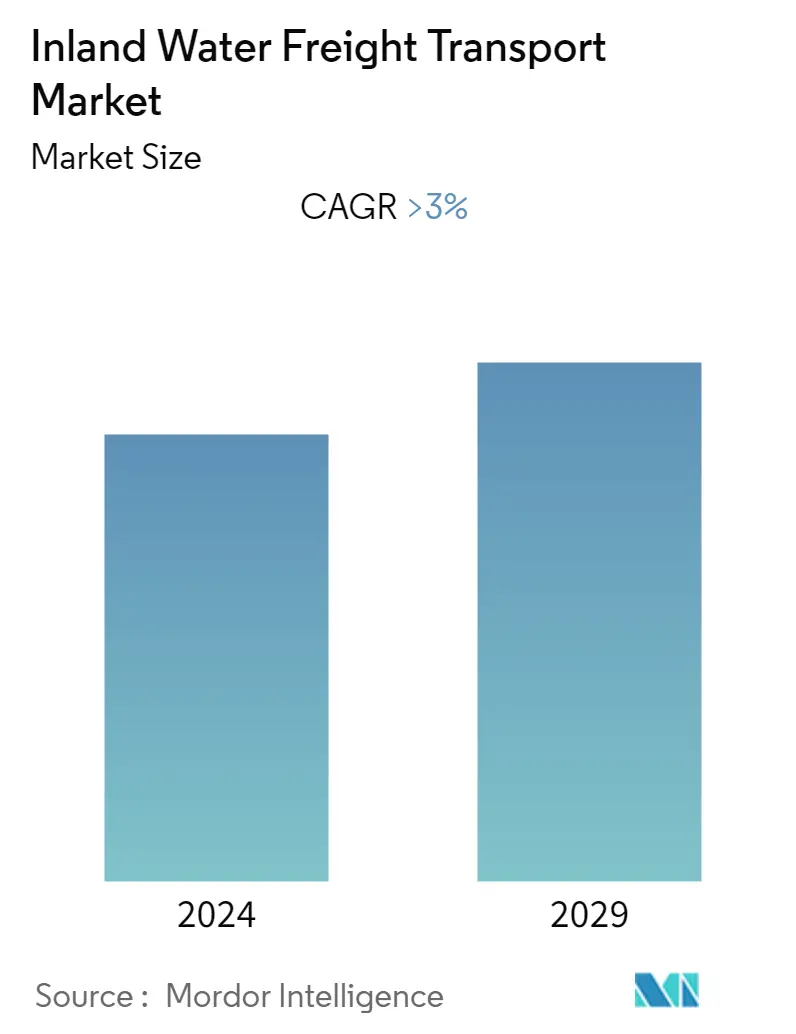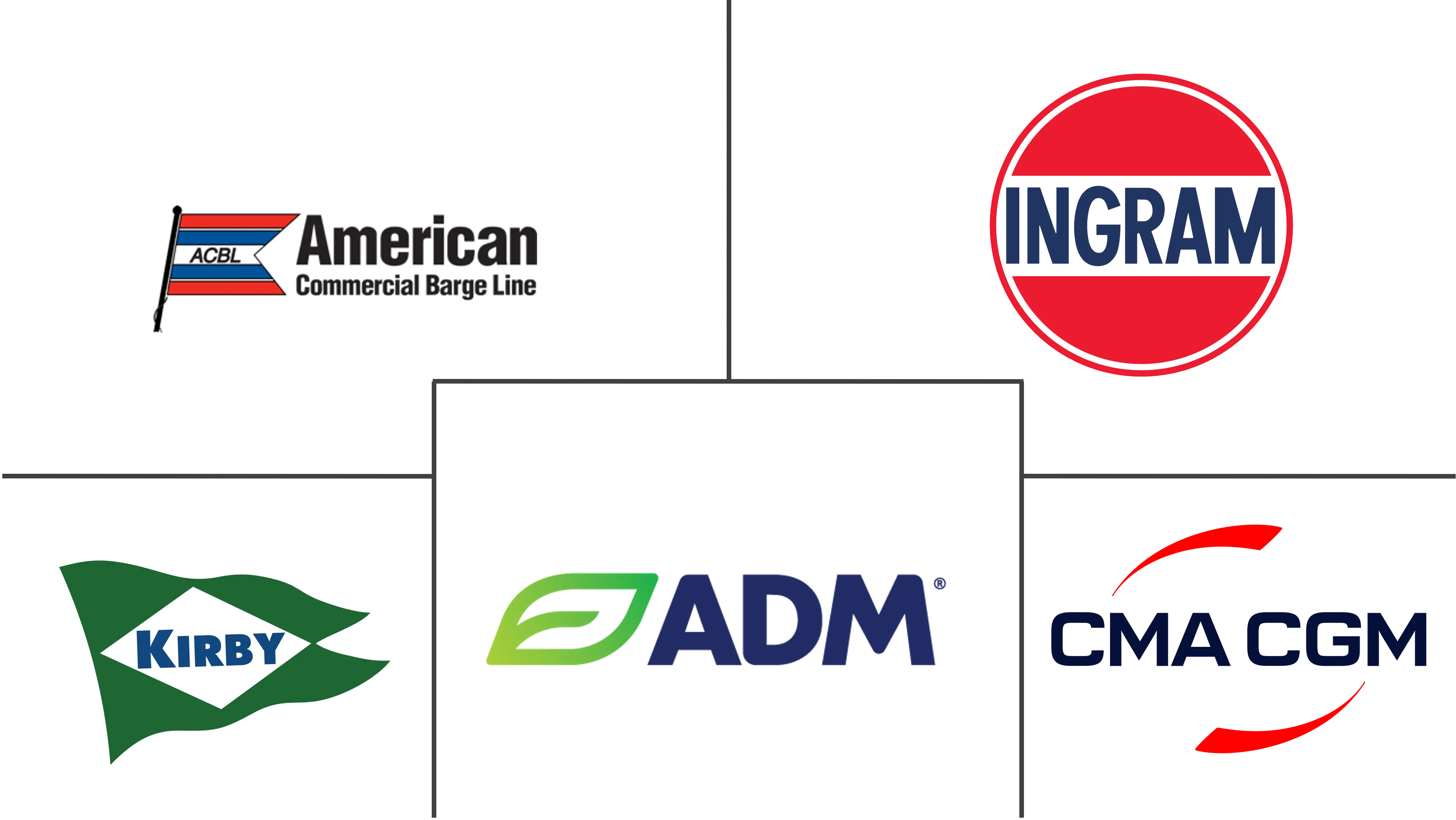Market Size of Inland Water Freight Transport Industry

| Study Period | 2020 - 2029 |
| Base Year For Estimation | 2023 |
| CAGR | 3.00 % |
| Fastest Growing Market | Asia-Pacific |
| Largest Market | Europe |
| Market Concentration | Low |
Major Players
*Disclaimer: Major Players sorted in no particular order |
Inland Water Freight Transport Market Analysis
The size of Inland Water Freight Transport market is USD 13.25 billion in the current year and is anticipated to register a CAGR of over 3% during the forecast period
- The inland water freight transportation market comprises companies (organizations, sole proprietors, and partnerships) that offer inland water freight transportation of cargo on lakes, rivers, or Intracoastal waterways. Only items and services that are exchanged between parties or sold to final customers are covered.
- The market for inland water freight transport has been primarily driven by the need for reasonable cargo transportation. Because of the discrepancy in fare pricing compared to other means of shipping, water freight is typically regarded as affordable and economical for heavy items. The cubic meter of the typical container is frequently used to determine the rate of water transportation. In contrast, the charged weight for air transportation is determined by taking into account both the size and weight of the cargo.
- An growing trend in the inland water freight transport business is the creation of information technology platforms for better vessel management. According to the United Nations Conference on Trade and Development (UNCTAD), in 2019, with a fleet of 95402 ships, nearly 80% of world trade was handled via waterways. Information technology is utilized on ships for customer relationship management, warehouse management, queuing systems, fuel optimization, monitoring vessel performance, and document recognition from scanned copies and images. BunkerEx, an online resource that assists ship owners in locating the best bunker ports, and Nautilus Labs, which uses data from sensors, manual reports, and market information to create a unified fleet intelligence, are two notable examples of online tools and portals used for operations management on ships.
- The market for inland water freight transport is anticipated to be hampered during the term due to the impact that crude oil price volatility is having on the water transportation industry. Fuel oil, which provides 95% of the energy used in worldwide transportation, is a significant source of powering the global economy, according to the United Nations Conference on Trade and Development. Increased fuel prices lead to product inflation and have an impact on all facets of product transportation. When fuel prices decline, consumers can purchase items for less, and logistics companies can utilize the money they save to enhance their operations. Operational costs are directly affected by variations in fuel prices.
- Although the COVID-19 epidemic affected marine travel, the effects were not as severe as first anticipated. Maritime trade decreased by 3.8% in 2020 as a result of the shock in the first half of the year. However, there was a tentative, though asymmetrical, recovery in the second half of the year, and by the third quarter, volumes had restored for both containerized trade and dry bulk commodities.
Inland Water Freight Transport Industry Segmentation
Any transportation of goods made with inland waterways vessels and completed entirely or in part on navigable interior waterways is referred to as inland water freight transport. Inland waterways transport refers to the transportation of goods made entirely on navigable inland rivers employing seagoing vessels. The Inland Water Freight Transport Market is segmented by Type of Transportation (Liquid Bulk Transportation, Dry Bulk Transportation), By Vessel Type (Cargo Ships, Container Ships, Tankers, Other Vessel Types), and by Geography (North America, Europe, Asia-Pacific, Latin America, and Middle East & Africa). The market sizes and forecasts are provided in terms of value (USD billion) for all the above segments.
| Type of Transportation | |
| Liquid Bulk Transportation | |
| Dry Bulk Transportation |
| Vessel Type | |
| Cargo Ships | |
| Container Ships | |
| Tankers | |
| Other Vessel Types |
| Geography | ||||||||
| ||||||||
| ||||||||
| ||||||||
| ||||||||
|
Inland Water Freight Transport Market Size Summary
The inland water freight transport market encompasses companies engaged in the transportation of cargo via lakes, rivers, and Intracoastal waterways. This sector is primarily driven by the cost-effectiveness of water transport compared to other shipping methods, making it an attractive option for heavy cargo. The market is witnessing a growing trend towards the integration of information technology platforms to enhance vessel management, including customer relationship management, fuel optimization, and performance monitoring. Despite challenges such as crude oil price volatility affecting operational costs, the market is poised for growth, supported by advancements in IT and AI technologies that improve efficiency and reduce emissions. The COVID-19 pandemic had a limited impact on the sector, with a gradual recovery in maritime trade volumes.
The inland water freight transport industry is also seeing significant developments in regional connectivity and international trade routes, particularly in Southeast Asia, where efforts are underway to link rivers across multiple countries. This initiative aims to enhance trade by creating a vast network of waterways, potentially boosting economic activities in the region. Major players in the market, such as American Commercial Barge Line and Ingram Barge, are actively involved in expanding their operations to capitalize on the growing demand for green cargo transport. The sector's expansion is further supported by initiatives to shift freight transport from road to inland waterways, promoting environmental sustainability and cost efficiency.
Inland Water Freight Transport Market Size - Table of Contents
-
1. MARKET DYNAMICS AND INSIGHTS
-
1.1 Current Market Scenario
-
1.2 Market Dynamics
-
1.2.1 Drivers
-
1.2.2 Restraints
-
1.2.3 Opportunities
-
-
1.3 Industry Attractiveness - Porter's Five Forces Analysis
-
1.3.1 Threat of New Entrants
-
1.3.2 Bargaining Power of Buyers/Consumers
-
1.3.3 Bargaining Power of Suppliers
-
1.3.4 Threat of Substitute Products
-
1.3.5 Intensity of Competitive Rivalry
-
-
1.4 Value Chain/Supply Chain Analysis
-
1.5 Technological Advancements
-
1.6 Government Regulations and Key Initiatives
-
1.7 Insights into Transshipment Trade
-
1.8 Insights into Containerized and Non-containerized Shipments
-
1.9 Freight Rates and Maritime Transport Costs
-
1.10 Insights into Intermodal/Container Utilization
-
1.11 Demand-Supply Analysis
-
1.12 Impact of COVID-19 on the Market
-
-
2. MARKET SEGMENTATION
-
2.1 Type of Transportation
-
2.1.1 Liquid Bulk Transportation
-
2.1.2 Dry Bulk Transportation
-
-
2.2 Vessel Type
-
2.2.1 Cargo Ships
-
2.2.2 Container Ships
-
2.2.3 Tankers
-
2.2.4 Other Vessel Types
-
-
2.3 Geography
-
2.3.1 North America
-
2.3.1.1 US
-
2.3.1.2 Canada
-
-
2.3.2 Europe
-
2.3.2.1 Germany
-
2.3.2.2 Netherlands
-
2.3.2.3 Romania
-
2.3.2.4 Belgium
-
2.3.2.5 France
-
2.3.2.6 Rest of Europe
-
-
2.3.3 Asia Pacific
-
2.3.3.1 India
-
2.3.3.2 China
-
2.3.3.3 Japan
-
2.3.3.4 Australia
-
2.3.3.5 Rest of Asia-Pacific
-
-
2.3.4 Latin America
-
2.3.4.1 Brazil
-
2.3.4.2 Argentina
-
2.3.4.3 Rest of Latin America
-
-
2.3.5 Middle East & Africa
-
2.3.5.1 UAE
-
2.3.5.2 Saudi Arabia
-
2.3.5.3 Rest of Middle East & Africa
-
-
-
Inland Water Freight Transport Market Size FAQs
What is the current Inland Water Freight Transport Market size?
The Inland Water Freight Transport Market is projected to register a CAGR of greater than 3% during the forecast period (2024-2029)
Who are the key players in Inland Water Freight Transport Market?
American Commercial Barge Line, Ingram Barge, Kirby Inland Marine, American River Transportation and CMA CGM Group are the major companies operating in the Inland Water Freight Transport Market.

